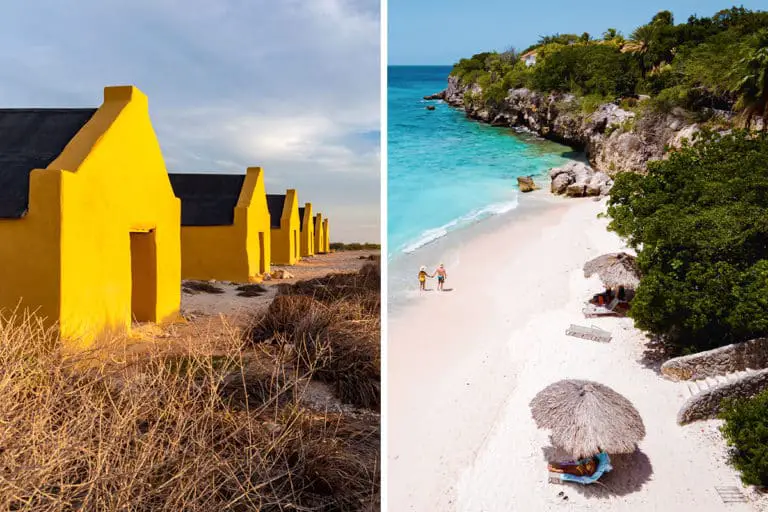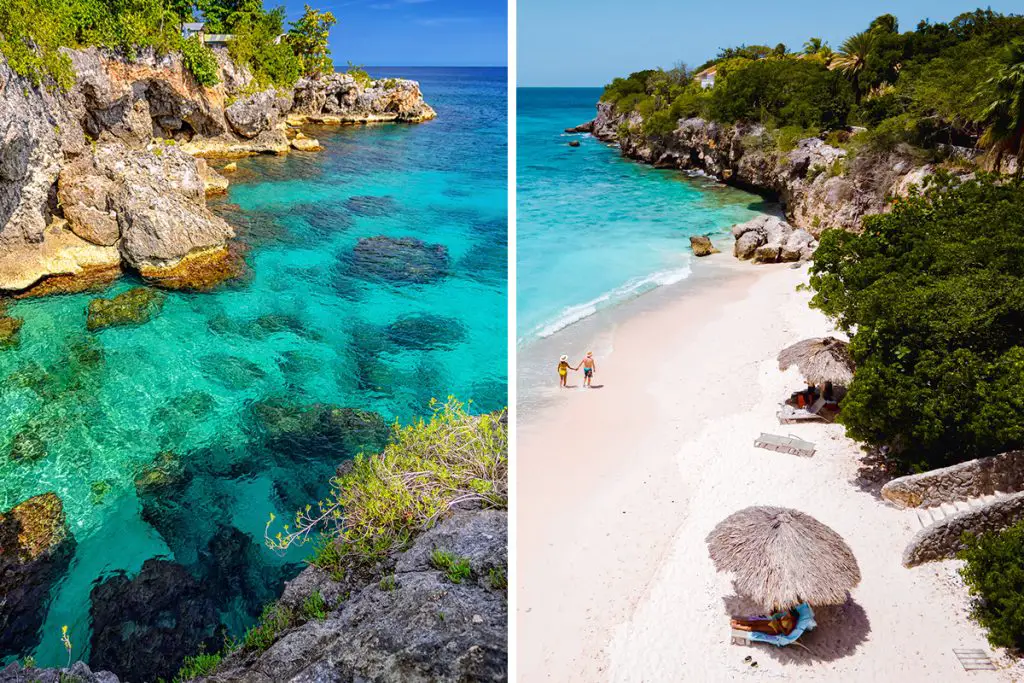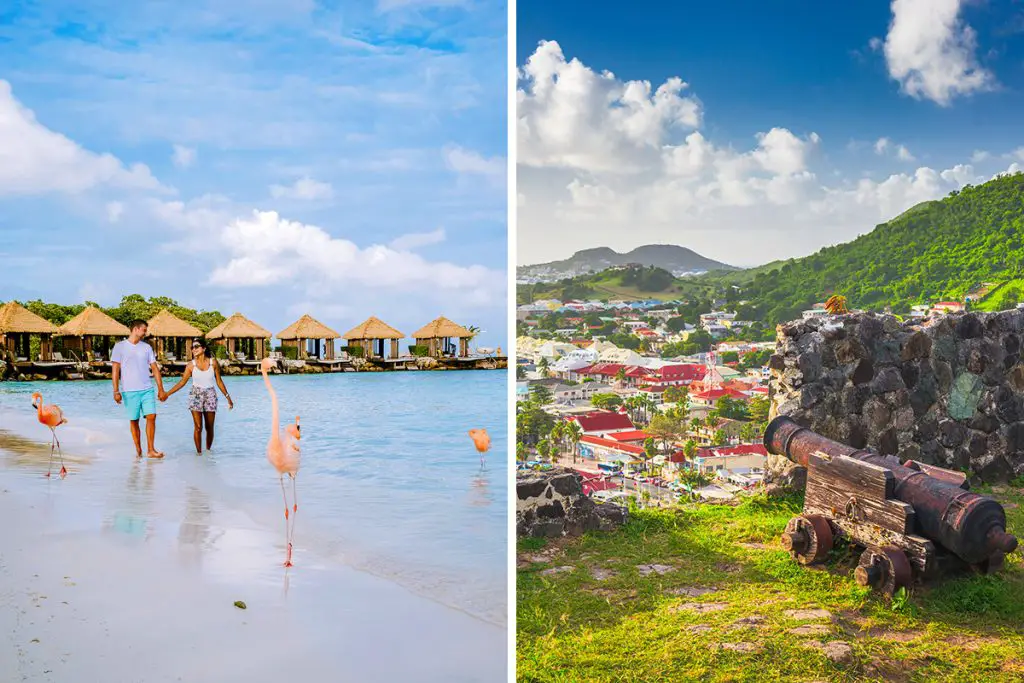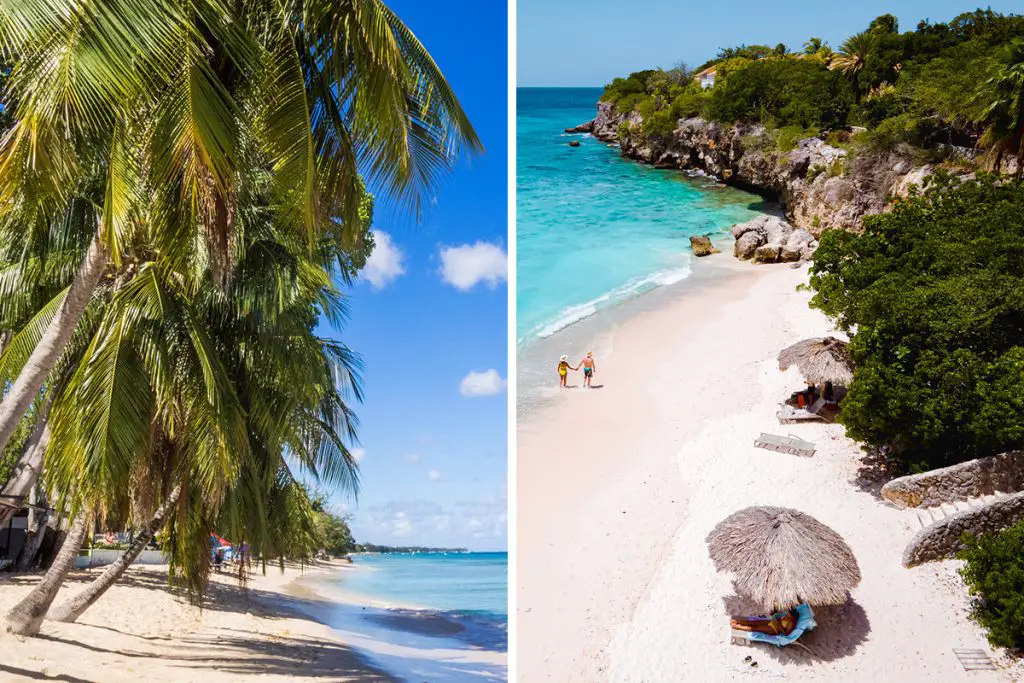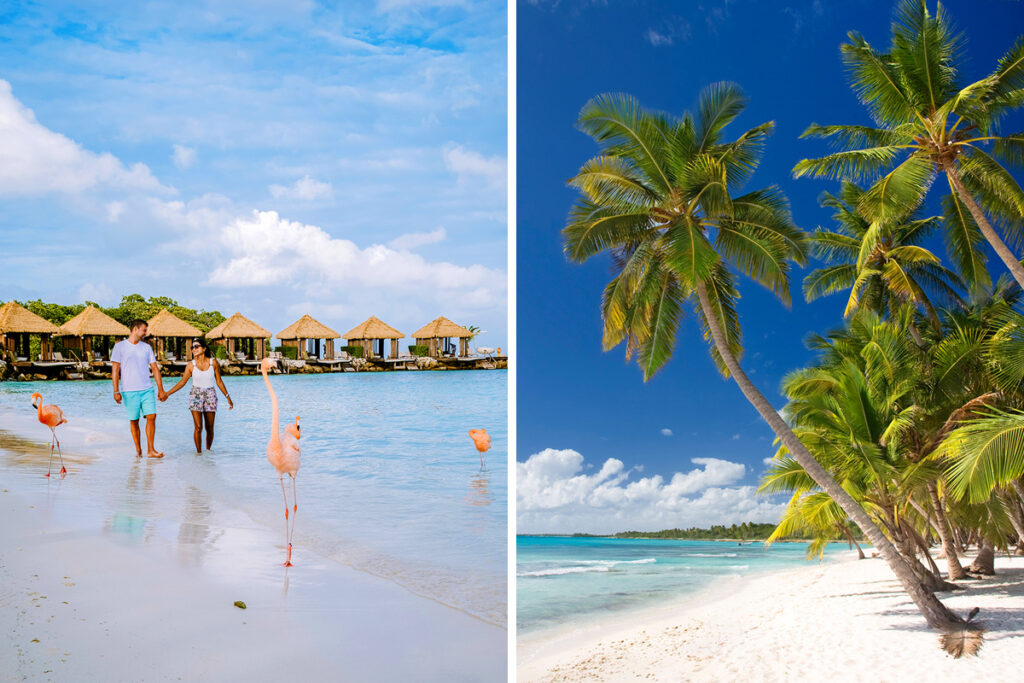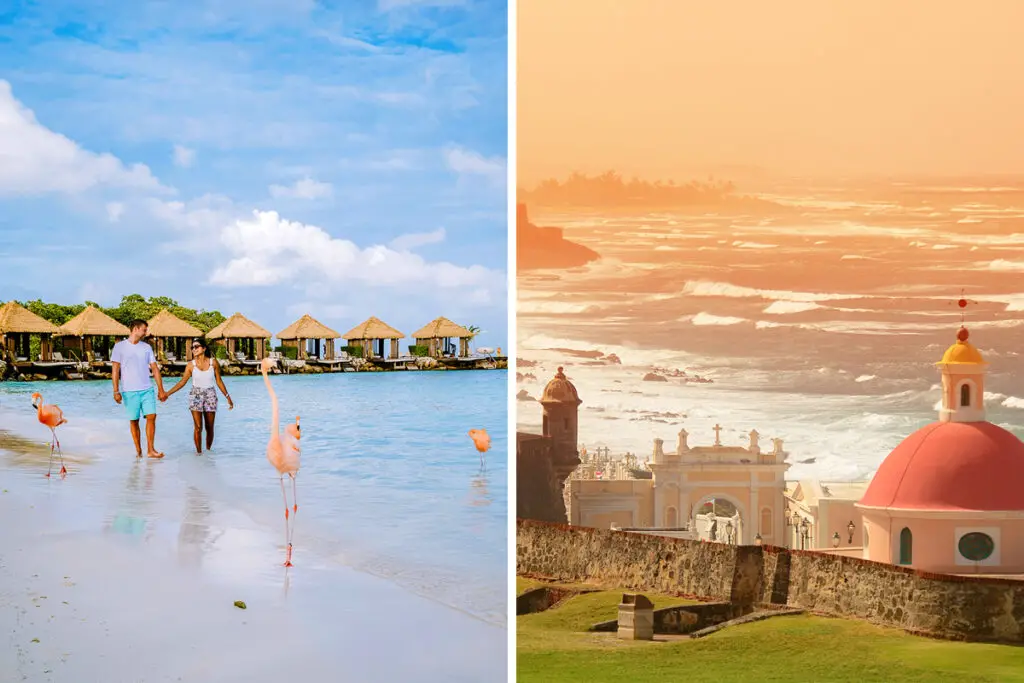Bonaire
Bonaire is a diver’s paradise and a nomad’s paradise, as one of the three most coveted ABC islands of the Dutch Caribbean. When you think of Aruba, you think of upscaled delights, more cosmopolitan with an intense resort feel, while Bonaire is excellent for rugged adventurers, slow budget travelers, and beach-lovers.
Bonaire is the least frequented of the ABC Islands, which means it is less congested, allowing for a more intimate and unique vacation experience. In addition to its seeming remoteness, the island is endowed with unrivaled beauty and wonderful weather, making it ideal for a more relaxed holiday with friends or a special someone. Bonaire is unquestionably unique, and it is grossly underappreciated.
What Makes Bonaire Unique?
A Scuba Diving Haven
When you search up Bonaire, you’ll notice that it’s a little island that’s big on diving and a variety of other water sports. Bonaire is one of the Caribbean’s greatest dive destinations. On Bonaire, scuba diving is popular, with over 90 spots offering challenges for divers of all levels in crystal clear water, allowing exploration of reefs, wrecks, and marine life. Many of Bonaire’s dive and snorkel spots, as well as windsurfing and other sports, provide great conditions for beginners young and old.
Because of the constant trade winds pouring in from the east, Bonaire is known for a variety of other watersports such as kiteboarding, windsurfing, and kitesurfing. You’ll find plenty of fun things to do on and around Bonaire’s waterways.
Conservation Efforts
Because of the island’s “underappreciation,” few people are aware of Bonaire’s role as an environmental advocate. Because the entire island is a National Park, expect conservation efforts to be aggressively imposed wherever you go on the island. Bonaire has been a leader in environmental conservation since the 1960s, starting with the protection of Caribbean flamingo breeding grounds and sea turtle nesting grounds.
The oceans around Bonaire are as safe as they get because it is a National Marine Park. That’s great news for you since it implies there will be plenty of healthy coral and fauna to go around. The Coral Restoration Foundation on Bonaire has a worthwhile coral reef restoration initiative, but first and foremost, all divers and snorkelers must pay a Nature Fee and wear a Nature Tag at all times while in the water.
The creation of Washington-Slagbaai Park and the Bonaire Marine Park demonstrated the island’s commitment to environmental protection. The Bonaire Marine Park has long been a leader in reef management and protection. Bonaire is also less popular with tourists than Aruba and Curacao, leaving the majority of the island untouched by mass tourism.
Near-Perfect Weather
Bonaire, like the other ABC islands, is situated far from the dangerous Caribbean Hurricane Belt, making it an excellent choice for a sunny vacation at any time of year. The island’s scorching temperatures are frequently moderated by the easterly trade winds, which also provide ideal conditions for a variety of watersports.
Rain falls on Bonaire from time to time, particularly during the summer months of June to late October. Rain falls more frequently throughout these months, although only for a brief time and only late in the day. However, the sun reigns supreme in the ABC islands, and you may visit at any time of year, depending on how you want your vacation to go.
Fewer Tourists, More Beauty
Bonaire is unique in that it is one of the last of its kind, with fewer tourists, unspoiled scenery, and pleasant weather. Bonaire is more of an unknown gem, or a lesser-known jewel among a sea of bigger tourist players, leaving it relatively unseen by most. Only tropical-loving Dutch residents and a bevy of water lovers, commonly known as Divers and other watersport aficionados, are aware of the tiny island.
When visiting Bonaire for the first time, you’ll immediately feel more at ease because you’ll be meeting more locals than tourists. You’ll also be faced with sheer, raw, unadulterated beauty, untainted and unaffected by mass tourism, thanks to the island’s government’s conservation initiatives, which they love to take to the highest heights. Consider how few people there are, how empty the beaches are, and how beautiful the natural scenery is. Bonaire is unquestionably unique.
Curacao
Curacao is sometimes referred to as the Caribbean’s best-kept secret because it is frequently neglected by seasoned tourists who prefer to visit well-known islands and destinations. The island retains a comparatively well-preserved charm as well as the natural beauty that can certainly compete. Willemstad’s many districts, with their 40+ beaches, several dive and snorkeling locations, cultural and cosmopolitan charms, and a charming colorful culture with an origin full of unique blends.
Apart from its outstanding natural beauty, which seems to be a recurring theme among the endowed Caribbean islands, it’s difficult to pinpoint what Curacao is best renowned for. Curacao is known for one thing: the perfect mixture of natural beauty, a wide range of activities, a diverse culture, and, yes, the weather.
What Makes Curacao Unique?
Water lovers’ Paradise
Curacao’s natural highlights are probably its best recipe for luring curious travelers. Thanks to the wealth of gifts bestowed by Mother Nature herself, Curacao is teeming with hype-worthy places to discover such as pristine beaches, coral reefs, submarine cliffs, interesting wildlife, and a thriving national park. You can never run out of places to explore in Curacao so it’s best to bring an adventurous spirit.
As for the island’s aquatic wonders, Curacao is blessed with over 40 beaches each having its flavor, providing diverse experiences to every type of beach bum out there. You can be sure to have white sand stretch for your liking, from the crowded to the supposedly private ones. Kenepa Beach, Playa PortoMari, and Mambo Beach are among the most well-known.
Curacao’s aquatic draws aren’t only limited to its coasts, the island is also known to be a diver’s haven, thanks to an abundance of dive sites that cater to divers of different levels and interests. Curacao features some of the world’s top diving sites, many of which are ideal for beginners. Off the Playa Porto Mari, you can go to Cas Abao and Porto Mari. The Booby Trap in the south is a great place to start for beginners.
And just as you thought that the island’s marine marvels are perfect selling points, head on to the northern shores and be taken away by the sheer natural beauty of Sheta Boka National Park. Contrasting to the rest of the island’s serene beaches, this one consists of jugged limestone ridges that. You can hike along paths to see sea turtles breeding, discover an underground cavern, or simply sit on the cliffs and watch the waves smash in, spraying water like fireworks.
The Capital Itself
When you first set foot in Curacao, you don’t have to go to the farthest reaches to get to interesting places. The capital of Willemstad itself is the stuff of proverbial cultural travel stories, brimming with quirks, and thrills a day alone exploring everything the city has to offer isn’t enough. Willemstad’s rather unique flavor stems from its rich mixed and diverse history, and a thriving modern culture that both embraces its roots and celebrates its growth.
After settling in your accommodation, you can begin your Curacao trip in old Willemstad. It is not as cosmopolitan as the other European capitals it is modeled after, but it is more historical with a Caribbean flavor. Think Amsterdam but tropical with a tinge of Caribbean pizzaz.
Visit the city’s several odd districts, such as Pietermaai, Punda, Scharloo, and others, for their individual flavors and to appreciate the small pleasures these neighborhoods bring. The best restaurants, clubs, and pubs can be found in Pietermaai, which is generally referred to as the city’s most active and throbbing neighborhood.
Punda is home to the famed Handelskade, as well as a Euro-Caribbean ambiance, colonial structures, and excellent dining and shopping. Scharloo is as colorful as they come; not only can you appreciate the bright residences, but you can also admire the imaginative and colorful street art.
Zero Hurricanes
One of the most defining draws of all the ABC Islands is its hurricane-free weather. A worry-free getaway to a tropical island is always a huge selling point and allows you to visit no matter what time of the year – well, except if you don’t like crowds and high prices, it is best to avoid the peak season. Curacao experiences pretty-much zero hurricanes, except for the occasional rain showers and winds from the trough of nearby tropical storms and hurricanes.
This is due to the fact that Curacao is located outside of the infamous Caribbean hurricane belt that occasionally terrorizes several islands in the region. Curacao doesn’t usually experience the severity of storms and hurricanes but it still doesn’t experience rain especially during the summer.
Nevertheless, this certain quirk is what makes Curacao and the rest of the ABC islands to be enticing to visit. A true vacation island paradise through and through.
Multicultural Wonders
Curacao, like the rest of the Caribbean, is heavily impacted by Europe, with a long history of European occupancy and control. First, the Spanish, British, and Duchess have been its most powerful allies. The island and its people are absolutely unique because of its fascinating past.
If you go to Willemstad, the island’s capital and cultural and historical hub, you can observe how far the Dutch influence has spread. The colorful colonial mansions and Dutch-style buildings that seemed like they came straight out of Amsterdam can be marveled at. Because of its historical significance and beauty, the city has been designated as a UNESCO World Heritage Site.
Willemstad and other historical areas of metropolitan Curacao have their own unique characteristics that make the island stand out. The residents’ multilingualism, the great fusion in their cuisine, and the incredible overall feel of the city are all incredible.
One of the Caribbean’s Best Kept Secret
Despite its tourist-drawing beauty, Curacao is often eclipsed by larger names and islands in the Caribbean, such as Jamaica, Barbados, the Dominican Republic, Belize, and even Mexico’s Yucatan Peninsula. The attractions in these locations compete with one another for first place.
Curacao’s underappreciated charms, cultural oddities, and a wealth of places and spots offer a diverse range of experiences for the appropriate kind of adventurer. It might not be everyone’s cup of tea, particularly for those who have had the best of other locales. Curacao, on the other hand, is ready to provide its peculiarities, charms, and enchantment to those who seek them.
This Dutch gem deserves all the attention it can get, with 40+ beaches, an abundance of dive sites ideal for beginners and experts, beautiful, historic, and cultural districts with the proper blend of modernity, multilingual friendly, loving people, and a variety of chances for a fantastic experience.
Which Is Better – Bonaire or Curacao?
Comparing Bonaire with Curacao is like deciding which of two sisters is better, even though both might be really intriguing and worthwhile if given the chance. The undoubtedly tempting Dutch sisters are among the greatest in the Caribbean, with somewhat different pulls that make it even more difficult for seasoned travelers to tell which is which.
Bonaire is the polar opposite of Aruba, as it is rugged and rustic, ideal for slow budget tourists and diving enthusiasts. The adventurous, backpackers, and chill, laid-back vacationers diligently seeking the highs of the classic Caribbean experience can find much to enjoy on this small island.
Curacao is the Caribbean’s best-kept secret, perhaps one of the best underrated islands in the world at large. This interesting island is the perfect hybrid destination for the well-rounded traveler. From the cultural highs provided by the colorful and vibrant capital of Willemstad to the natural charms of its myriads of beaches and dive spots around its waters. Curacao is criminally underrated indeed.
FAQ
Cost of Living in Curacao Vs. Bonaire
When it comes to prices and expenses, the two only have small differences depending on certain products and services. You can easily see the cost disparities if you compare simple purchases, or how much certain services cost in both places. However, the thing is with the Dutch Caribbean Islands, there can be the most expensive places in the Caribbean.
Buying an inexpensive meal in Bonaire can cost around 10 to 20 USD, but in Curacao, they tend to cost 1 to 2 USD more. However, a one-way transport ticket in Bonaire costs more than in Curacao, as well as a liter of gas. Essential purchases such as a liter of milk, meats, and other smaller purchases cost around the same in Curacao and Bonaire.
You can have a daily budget of roughly 250 to 300 USD, or an estimated 2,000 USD per week for a single person if you accumulate and work around the prices and costs. Both destinations are not particularly expensive or cheap in contrast to other Caribbean destinations.
Diving in Curacao vs. Bonaire
Bonaire easily takes the bag as the better destination for diving on the southern side of the Caribbean. Often hailed as a diver’s paradise, Bonaire boasts around 90 world-class dive sites that are ideal for different levels of dives, offering a variety of features that can enchant scuba and free divers from all over the world.
When you visit Bonaire, you can easily surmise how big its ever-thriving diving culture is, thanks to Bonaire being a whole national park and reserve in itself. Each dive site is perfectly conserved and protected for the continuous thriving of marine life. Bonaire knows how much beauty it holds and it does everything to protect.
Snorkeling in Bonaire vs. Curacao
Bonaire’s waters are legally protected so you can easily see marine life that comes in a wide variety perfect for the avid diver. Curacao, on the other hand, may be underwhelming for some especially those who are actually looking for a decent dive. This may be largely due to the fact that Curacao’s waters aren’t as protected as Bonaire’s. Which can be risky for the resident marine life.
Bonaire vs. Curacao for Cruise
Curacao is the bigger fish when it comes to cruising because cruise access to Bonaire came about just recently and it’s fairly juvenile. However, because of its being relatively new to the Caribbean’s long roster of cruise-worthy islands, Bonaire can be the shiny new toy in the blue waters of the famed sea.
However, the thing with Bonaire is that it’s best for rugged travelers, backpackers, and diving enthusiasts. It’s not as upscale as Aruba, and not as tourist-oriented as Curacao, rather it prides itself on the quietness of its shores, and the intimacy of its towns and sites.
What Airlines Fly From Curacao to Bonaire?
Thanks to their proximity and cultural and political affiliation, there are several airlines that can take you from Curacao to Bonaire and even vice versa. You can easily fly via Divi Divi air, TullFly, EZ Air, Air Antilles, Insel Air, and many more.

